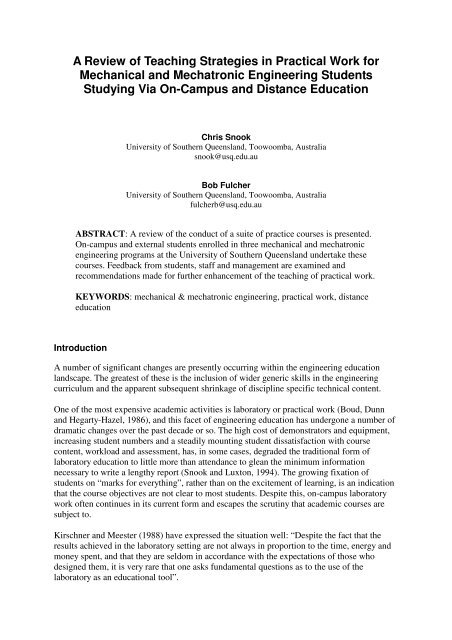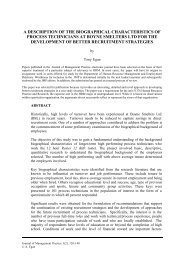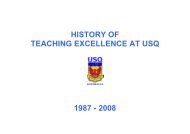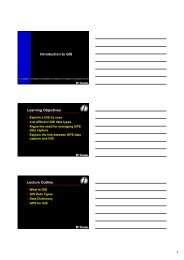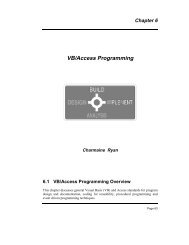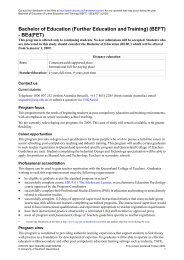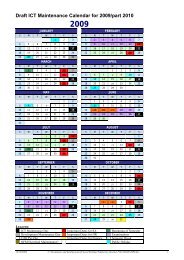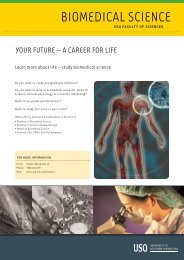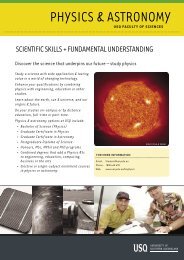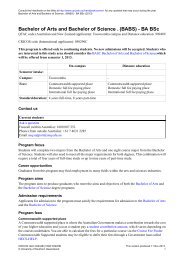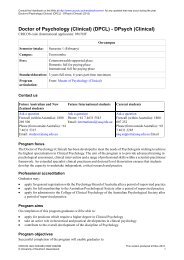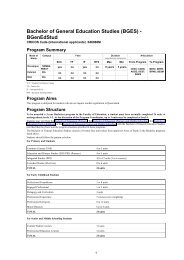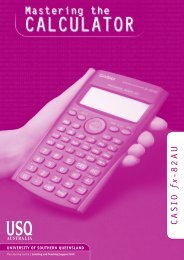CutePDF Printer, Job 4 - University of Southern Queensland
CutePDF Printer, Job 4 - University of Southern Queensland
CutePDF Printer, Job 4 - University of Southern Queensland
Create successful ePaper yourself
Turn your PDF publications into a flip-book with our unique Google optimized e-Paper software.
A Review <strong>of</strong> Teaching Strategies in Practical Work forMechanical and Mechatronic Engineering StudentsStudying Via On-Campus and Distance EducationChris Snook<strong>University</strong> <strong>of</strong> <strong>Southern</strong> <strong>Queensland</strong>, Toowoomba, Australiasnook@usq.edu.auBob Fulcher<strong>University</strong> <strong>of</strong> <strong>Southern</strong> <strong>Queensland</strong>, Toowoomba, Australiafulcherb@usq.edu.auABSTRACT: A review <strong>of</strong> the conduct <strong>of</strong> a suite <strong>of</strong> practice courses is presented.On-campus and external students enrolled in three mechanical and mechatronicengineering programs at the <strong>University</strong> <strong>of</strong> <strong>Southern</strong> <strong>Queensland</strong> undertake thesecourses. Feedback from students, staff and management are examined andrecommendations made for further enhancement <strong>of</strong> the teaching <strong>of</strong> practical work.KEYWORDS: mechanical & mechatronic engineering, practical work, distanceeducationIntroductionA number <strong>of</strong> significant changes are presently occurring within the engineering educationlandscape. The greatest <strong>of</strong> these is the inclusion <strong>of</strong> wider generic skills in the engineeringcurriculum and the apparent subsequent shrinkage <strong>of</strong> discipline specific technical content.One <strong>of</strong> the most expensive academic activities is laboratory or practical work (Boud, Dunnand Hegarty-Hazel, 1986), and this facet <strong>of</strong> engineering education has undergone a number <strong>of</strong>dramatic changes over the past decade or so. The high cost <strong>of</strong> demonstrators and equipment,increasing student numbers and a steadily mounting student dissatisfaction with coursecontent, workload and assessment, has, in some cases, degraded the traditional form <strong>of</strong>laboratory education to little more than attendance to glean the minimum informationnecessary to write a lengthy report (Snook and Luxton, 1994). The growing fixation <strong>of</strong>students on “marks for everything”, rather than on the excitement <strong>of</strong> learning, is an indicationthat the course objectives are not clear to most students. Despite this, on-campus laboratorywork <strong>of</strong>ten continues in its current form and escapes the scrutiny that academic courses aresubject to.Kirschner and Meester (1988) have expressed the situation well: “Despite the fact that theresults achieved in the laboratory setting are not always in proportion to the time, energy andmoney spent, and that they are seldom in accordance with the expectations <strong>of</strong> those whodesigned them, it is very rare that one asks fundamental questions as to the use <strong>of</strong> thelaboratory as an educational tool”.
Distance education (also called external or <strong>of</strong>f-campus studies) is now becoming morecommon in the engineering education landscape. This relatively new mode <strong>of</strong> educationbrings new problems for the provision <strong>of</strong> practical work, but also provides an opportunity toreassess the role <strong>of</strong> practical work in both modes <strong>of</strong> study.In this paper, a brief review <strong>of</strong> a suite <strong>of</strong> practice courses is presented. These practice coursesare <strong>of</strong>fered to on-campus and external students and feedback from students and staff isdiscussed.Programs at USQThe <strong>University</strong> <strong>of</strong> <strong>Southern</strong> <strong>Queensland</strong> (USQ) is a recognised leader in the field <strong>of</strong> distanceeducation (ICDE, 1999), and also <strong>of</strong>fers somewhat more traditional on-campus studies. USQwas established in 1992, some 25 years after the opening <strong>of</strong> the Darling Downs Institute <strong>of</strong>Advanced Education from which it originated.The Faculty <strong>of</strong> Engineering and Surveying is one <strong>of</strong> the foundation faculties at USQ and<strong>of</strong>fers a wide range <strong>of</strong> on-campus and external studies in engineering. It <strong>of</strong>fers three programswithin the discipline <strong>of</strong> mechanical engineering; associate degree (AD), bachelor <strong>of</strong>engineering technology (BEngTech) and bachelor <strong>of</strong> engineering (BEng). In addition, there isa bachelor <strong>of</strong> engineering major in mechatronic engineering. All <strong>of</strong> these programs may beundertaken on-campus or via the distance education mode.Associate DegreeThe Associate Degree in Mechanical Engineering is a two year full-time program (or fouryears externally) that has been developed for those students whose aim is a career as aChartered Engineering Officer. Engineering Officers apply practical analysis and standardtechnical principles to new and existing areas <strong>of</strong> design, testing, inspection, operation andmanufacturing processes. They <strong>of</strong>ten work, "at the coal-face", as support staff to Pr<strong>of</strong>essionalEngineers.Bachelor <strong>of</strong> Engineering TechnologyA Mechanical Engineering major is available in the three year full-time Bachelor <strong>of</strong>Engineering Technology (BEngTech) program. This program can also be studied externallyover six years.The BEngTech award leads to a career as a Chartered Engineering Technologist. At USQwe believe that engineering technologists and engineering <strong>of</strong>ficers are best educated alongsidetheir pr<strong>of</strong>essional counterparts. In all engineering disciplines there is a need for suitablyqualified engineering technologists to work with and under the direction <strong>of</strong> Pr<strong>of</strong>essionalEngineers.Bachelor <strong>of</strong> EngineeringThe Bachelor <strong>of</strong> Engineering (BEng) program at USQ leads to a career as a CharteredPr<strong>of</strong>essional Engineer. Pr<strong>of</strong>essional Engineers develop solutions to problems in new andexisting fields <strong>of</strong> research, development, construction and manufacturing. They use advancedskills and knowledge in analysis, design, science, technology and management to find thosesolutions. The Pr<strong>of</strong>essional Engineer may not spend as much time doing "hands-on" practicalwork, but require considerable practical experience to supplement their technical andpr<strong>of</strong>essional training.
Practice StrandIn 1998, the Mechanical and Mechatronic Engineering discipline at USQ separated thepractical work from the academic courses in all <strong>of</strong> its programs. It now utilises nine practicecourses to support its programs and these are considered as the Practice Strand (Walkington,Pemberton and Eastwell, 1993) shown in Table 1. In this table, the practice courses areattributed to the relevant engineering program.Each practice course represents a notional 50 hours <strong>of</strong> student effort. On-campus studentsnormally conduct this work for three hours per week throughout the semester, whilst externalstudents attend a one week intensive residential school on-campus. A central feature <strong>of</strong> thissuite <strong>of</strong> practice courses is the decoupling <strong>of</strong> practical work from the academic courses.Instead, videos and computer demonstrations are used where a practical context is required tosupplement the academic material within a course. Thus, the practice courses are free toconcentrate on the specific educational goals <strong>of</strong> the practice experience.ADBEngTechBEng (Mech)Beng (Mtron)(((((((M'tronic)Engineering Practice 1 √ √ √ √Electrical Practice A√Mechanical Practice 1 √ √ √ √Mechanical Practice 2 √ √ √ √Mechanical Practice 3 √ √ √Mechanical Practice 4 √ √Mechatronic Practice√Pr<strong>of</strong>essional Practice 1 √ √Pr<strong>of</strong>essional Practice 2 √ √Table 1 Practice courses in each <strong>of</strong> the Mechanical Engineering programsEngineering Practice 1 (ENG1901)Engineering Practice 1 is intended primarily to cater for the needs <strong>of</strong> recent school leavers andpeople with limited working experience in engineering industry. A student with a tradecertificate and sufficient industry experience may be able to claim exemption from the course.This course is the first <strong>of</strong> a series <strong>of</strong> practice courses that are intended to enable students toacquire engineering and pr<strong>of</strong>essional practice skills. Engineering practice skills, such as theability to perform practical and project work, innovation, problem identification and solution,and engineering judgement, are developed as students progress through their programmes <strong>of</strong>study through activities such as laboratory and field work, engineering design and projectwork. Students generally work in teams to assist with the building <strong>of</strong> group interaction skillssuch as negotiation and interactive thinking.In this introductory course, external students attend a residential school for one week andundertake practical work primarily in the areas <strong>of</strong> instrumentation and measurement, orengineering materials and manufacturing. They prepare a comprehensive report and present a
seminar on one aspect <strong>of</strong> this work. Students are also introduced to the library and computingfacilities <strong>of</strong> the <strong>University</strong> and are expected to utilise these resources in the compilation <strong>of</strong>their reports and seminars. A series <strong>of</strong> keynote addresses are staged to assist students withtheir task.On campus students also undertake practical work in the areas <strong>of</strong> instrumentation andmeasurement, or engineering materials and manufacturing, and prepare a comprehensivereport and present a seminar. For these students, the practical work is performed throughoutthe semester. All students are introduced to the Workplace Health and Safety Act andundertake a preliminary workplace health and safety exercise.Mechanical Practice 1 (MEC2901)This course presents a series <strong>of</strong> activities designed to develop specific skills and knowledgerelevant to Mechanical Engineering. These activities are carried out on an individual or smallgroup basis, and the student team-work through a smorgasbord <strong>of</strong> activities until the specificcourse objectives are met. Typical activities include linear measurement, performancemeasurement, simple mechanical workshop exercises and device strip and assembly.Mechanical Practice 2 (MEC2902)This course falls naturally into three parts: Part One consists <strong>of</strong> a design activity where asmall team <strong>of</strong> students develop a design concept for a device capable <strong>of</strong> satisfying a broadlyspecified task. Part Two comprises the procurement <strong>of</strong> appropriate resources and theconstruction <strong>of</strong> the device in accord with the design specification developed in Part One. PartThree covers the testing <strong>of</strong> the device and encourages the student to reflect on the activitiesand outcomes <strong>of</strong> the work conducted in Part One and Part Two above.The Warman Student Design and Build Competition forms the basis <strong>of</strong> the design activityand is used exclusively as the vehicle for this practice course, including the nationalcompetition perspective. On-campus students conduct the work in this practice coursethroughout the first semester in a three hour class per week. External students attend a oneweekblock in the second semester, and thus are not directly involved in the NationalCompetition.Mechanical Practice 3 (MEC3903)This course continues the development undertaken in mechanical practice 1 and mechanicalpractice 2.On completion <strong>of</strong> this course, students should be able to: conduct and utilise an engineeringtest in accord with a given general requirement; operate a range <strong>of</strong> engineering metrologyequipment and evaluate the data obtained; co-operate within a team-work environment;review CNC machining processes; prepare CNC programs to machine a number <strong>of</strong> simpleengineering components; participate in the CNC machining process for two simpleengineering components.Mechanical Practice 4 (MEC3904)This course aims at providing the student with practical skills needed in many industrialprocesses. It is designed to demonstrate the different ways <strong>of</strong> measuring velocity <strong>of</strong> a fluid(gas or liquid), to determine the forces due to fluids, and temperature <strong>of</strong> a fluid or a solid andheat flux, to estimate flow rates and head losses in fluid systems, and heat flux in thermalsystems. The course is designed to help students review some <strong>of</strong> the basis <strong>of</strong> fluid mechanicsand heat transfer as well as validate and relate these to practical situations.
Mechatronic Practice (MEC3905)In mechatronics; mechanical, electrical and computing elements are combined to form anintegrated whole. This course draws together mechanical, electrical, s<strong>of</strong>tware and interfacingaspects <strong>of</strong> a mechatronic system through a progressive sequence <strong>of</strong> experiments. A motor isconnected to a computer through a power amplifier, while another motor in tandem ismonitored through an analogue interface to determine its speed. A line or two <strong>of</strong> code makesspeed control possible. A belt drives a 'trolley' <strong>of</strong> which the position is monitored and moreeffort includes nonlinear strategies to result in a 'crisp' position controller <strong>of</strong> an industrialstandard. An inverted pendulum is added to the trolley and the student devises a controlscheme to keep it balanced. Several further, brief experiments give familiarity with pneumaticpositioning, simple vision interfacing and a hydraulic robot. This course was developed toround <strong>of</strong>f the formation <strong>of</strong> a mechatronics engineer.Electrical & Electronic Practice A (ELE1911)This course is service taught from Electrical discipline into the Mechatronic engineeringprogram and until recently consisted <strong>of</strong> two practice courses.Pr<strong>of</strong>essional Practice 1 (ENG3902)This is the first <strong>of</strong> two courses, which address, in a generic sense, the practice <strong>of</strong> pr<strong>of</strong>essionalengineering. The course is concerned largely with non-technical matters, generallyindependent <strong>of</strong> the specific engineering disciplines, which involve the particular workundertaken, performance and responsibilities borne by the pr<strong>of</strong>essional engineer.The major manifestations <strong>of</strong> this pr<strong>of</strong>essional practice are the participation in pr<strong>of</strong>essionaldevelopment activities and the planning, execution and reporting <strong>of</strong> project work. Thispreparation includes attendance at the annual "Project Conference" in which Pr<strong>of</strong>essionalPractice 2 students present their completed project work to other students, staff and members<strong>of</strong> various pr<strong>of</strong>essions. Students also participate in, and report on, a range <strong>of</strong> laboratorysessions, demonstrations, seminars and workshops provided both by staff <strong>of</strong> the Faculty andby industry. These activities (labelled "Booths") seek to provide the student with some insightinto the "cutting edge" <strong>of</strong> current engineering practice.Pr<strong>of</strong>essional Practice 2 (ENG3903)This course is concerned with developing in the student an awareness <strong>of</strong> pr<strong>of</strong>essional ethics,environmental responsibilities and sustainability principles. This course also providesguidance and experience in both verbal (seminar) and written reporting skills and isundertaken to complement the formal presentation <strong>of</strong> the students honours project.Review <strong>of</strong> practice coursesTable 2 shows the enrolments in the practice courses from their introduction in 1998 to thepresent 2002 semester 1. Note where there are two numbers given then this indicates semester1 and 2 figures respectively. Day (D) and external (X) <strong>of</strong>ferings are included. All courseshave shown healthy numbers except mechatronic practice, which reflects low first levelenrolments in this recently introduced program. In a recent review <strong>of</strong> its undergraduateprograms, the faculty examined the current suite <strong>of</strong> practice courses and no changes wererecommended (Dowling, 2001).
Broj: 8/2004 “SLUŽBENI GLASNIK GRADA POREA” Strana:471OPE ODREDBElanak 3.0.1.(1) Detaljni plan ureenja "Gradsko kupalište Pore" (daljnjem tekstu : Plan) jedugoroni prostorno-planski dokument, koji u skladu sa ciljevima i zadacimautvrenim važeim prostornim planovima šireg podruja (Prostorni plan ureenjaGrada Porea /"Sl.glasnik Grada Porea", br. 14/02./ i Generalni urbanistiki plangrada Porea /"Sl.glasnik Grada Porea", br. 11/01./) i Programom mjera zaunapreenje stanja u prostoru utvruje smjernice za ureenje podruja, osnove uvjetakorištenja, ureenja i zaštite prostora na podruju Gradskog kupalište u Poreu.(2) Planom se utvruju dugorone osnove organiziranja i ureivanja prostoranavedenog podruja u skladu sa ciljevima i zadacima društveno - gospodarskograzvoja Grada Porea, a posebno:- osnovna podjela prostora po namjeni, s uvjetima njegovog ureivanja,- sustav infrastrukturnih koridora i graevina, te njihovo povezivanje sasustavom susjednog i šireg podruja,- mjere ouvanja i zaštite integralnih vrijednosti prostora, te prirodnih iambijentalnih vrijednosti,- mjere zaštite i unapredjivanja okoliša,- mjere provedbe Plana.lanak 4.0.2.(1) Plan je izraen u skladu s odredbama Zakona o prostornom ureenju (NN30/94, 68/98. 61/00. i 32/02.) i Pravilnika o sadržaju, mjerilima kartografskih prikaza,obveznim prostornim pokazateljima i standardu elaborata prostornih planova (NN106/98. 39/04. i 45/04.).(2) Svi elementi na temelju kojih e se izdavati odobrenja za graenje, a kojinisu posebno navedeni u ovom Planu, odreuju se na temelju odredbi važeegprostornog plana šireg podruja.lanak 5.0.3.(1) Plan se donosi za podruje obuhvata prikazano u grafikom dijelu Plana,ukupne površine cca 19,8 ha., od ega se 13,8 ha odnosi na kopneni dio podruja, a6,0 ha na akvatorij.(2) Plan se donosi za:- dio naselja Pore,- dio Mjesnog odbora "Anke Butorac",- dio katastarske opine Pore,- dio graevinskog podruja naselja Pore.(3) Podruje obuhvata Plana nalazi se u zoni maksimalnog intenziteta 7 o MSKprema seizmološkoj karti.(4) Podruje obuhvata Plana nalazi se u 1. klimatskoj zoni.471
Allocate more time to MechPrac1 so you have the chance to do all the activities.No. Wait until you get a job and have proper practical experience.Add an electrical practice course for Mechanicals.Add another course where you have a problem and have to solve it.Add more time to Mechatronics Practice with more hands on experience withmechatronic systems. (x3)Add specific experience with PLC's (x2). Add specific experience with visionsystems.Add a Dynamics practice course.A few more hours <strong>of</strong> everything would be good.Examiner CommentsIn general, the examiners <strong>of</strong> each <strong>of</strong> the practice courses were pleased with the way in whichtheir course was conducted. The following points merit discussion:Students generally perform well but two <strong>of</strong> the examiners were concerned that thestudent's knowledge <strong>of</strong> background theory was lacking.On-campus and external students generally complete the practice work within theallotted time. However, students in Mechanical Practice 2 and MechatronicPractice tended to spend much longer on the practice work (because they enjoyeddoing so). As examiners we do not wish to stifle such enthusiasm but areconcerned that this may have an adverse effect on the student's academic courses.It is alarming to note that most examiners knew little <strong>of</strong> the content or conduct <strong>of</strong> theother practice courses. Despite this, they thought there may be no clear andcoherent theme to the practice courses.Management CommentsThere is no formal student evaluation survey <strong>of</strong> practice courses as in the academic courses.The academic instrument is not appropriate for this purpose and no alternative was evercreated. In many ways the review discussed in this paper was initiated because <strong>of</strong> thisoversight.Sequencing <strong>of</strong> practice courses generally follows their corresponding academic courses but isnot fixed by prerequisites or co requisites. Students following the recommended enrolmentpattern will do the practice courses in order. This order is not actually necessary and someslight variation is acceptable.The timetable for external students attending residential school may need to be adjusted. Atpresent some practice courses run in the same week. This is a particular problem for overseasstudents who must then travel to Australia many times for a one week block when they wouldrather travel half as <strong>of</strong>ten but for two weeks at a time.Practice courses have simplified and justified the attendance <strong>of</strong> external students at residentialschools on campus. Given that most overseas students attending have considerable travellingand accommodation costs, this is now easier to explain and facilitate.
ConclusionsThe work within the Mechanical Engineering Practice Strand is generally popular amongststudents. Both staff and students perceive benefits in the sequencing and in the particularpractical work component.Students have fully realised the aims <strong>of</strong> practice work and appreciated its place in theirprograms and even suggested it might be increased to cover more academic areas.The Discipline should consider renaming the practice courses to better describe their contentand to remove the implicit sequencing requirement.The Discipline should consider sharing knowledge <strong>of</strong> practice course content across allexaminers involved so that common outcomes maybe reinforced.Practice courses are quite expensive and any expansion therein will need to be well argued intheir cost-effective contribution to undergraduate outcomes per the recent accreditationreview.Practical work is doubly expensive when considering students who enrol via the externalmode. In this case, the Faculty bears the considerable cost <strong>of</strong> demonstrators, equipment andlaboratory space; whereas the student must take leave from work and pay for travel andaccommodation at USQ.The Faculty <strong>of</strong> Engineering and Surveying needs to develop a formal evaluation instrumentspecific to the practical work objectives.ReferencesBoud, D., Dunn, J. & Hegarty-Hazel, E. (1986). Teaching in laboratories. SRHE&NFER-Nelson, UK.Dowling, D. (2001). Review at USQ: Redeveloping the bachelor <strong>of</strong> engineering program for 2002. In L. Dawes,W. Boles & A. Maeder (Eds.), Proceedings <strong>of</strong> the 12th AAEE conference on engineering education. (pp.309-314). Brisbane, Australia.International Council for Open and Distance Education (ICDE), 1999 Prize <strong>of</strong> Excellence for Institutions,http://www.icde.org/Kirschener, P.A. & Meester, M.A.M. (1988). The laboratory in higher education: Problems, premises andobjectives. Higher Education, 17, 81-89.Snook, C.P., & Luxton, R.E., A challenge for laboratory based learning programs. In P.J. Parr & S.F. Johnston(Eds.), Proceedings <strong>of</strong> the 6th annual convention and conference <strong>of</strong> the Australasian Association forEngineering Education, (pp. 772-777). Sydney, Australia.Walkington, J., Pemberton, P. & Eastwell, J. (1993). Laboratory work in external engineering courses. In R.M.Sharp & H. Silyn-Roberts (Eds.), Proceedings <strong>of</strong> the 5th AAEE conference on engineering education. (pp.401-406). Auckland, New Zealand.


